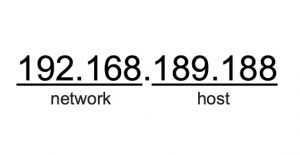Difference between revisions of "IP address"
(Created page with "An Internet Protocol (IP) address is a series of digits that identifies different devices within a network. Category: Glossary") |
|||
| (14 intermediate revisions by the same user not shown) | |||
| Line 1: | Line 1: | ||
An Internet Protocol (IP) address is a | [[File:Ipv4 address.svg|thumb|Ipv4 address]] | ||
An [[Internet Protocol]] (IP) address is a unique combination of digits that identifies machines within an interconnected network. They are automatically assigned by routers when devices connect to a network. | |||
Most IPs (from Internet Protocol version 4) are made up of strings of numbers separated by periods. Each number in the set can range from 0 to 255. So, the full IP addressing range goes from 0.0.0.0 to 255.255.255.255. | |||
IP addresses are local (private), or public. Every device that connects to your internet network has a local IP address. This includes computers, smartphones, and tablets but also any Bluetooth-enabled devices like speakers, printers, or smart TVs. A firewall separates your local network from the outside, so only devices connected to the same local network can inter-connect. | |||
Local IP addresses are on the [[LAN: Local Area Network|LAN]], or local area network, and public IP addresses are on the [[WAN: Wide Area Network|WAN]], or wide area network. | |||
Every IP address is composed of parts that identify a network and a host: | |||
[[File:IP_breakdown.jpg|300px|frameless|The components of an IP address]] | |||
{| class="wikitable" | |||
! scope="row" style="text-align:left;" | Network part | |||
| This part specifies the unique number assigned to your network. It also identifies the class of network assigned. | |||
|- | |||
! scope="row" style="text-align:left;"| Host part | |||
| This is the part of the IP address that is assigned to each host. It uniquely identifies this machine on your network. Note that for each host on your network, the network part of the address will be the same, but the host part must be different. | |||
|- | |||
|} | |||
[[Category: Glossary]] | [[Category: Glossary]] | ||
Latest revision as of 23:32, 24 November 2021
An Internet Protocol (IP) address is a unique combination of digits that identifies machines within an interconnected network. They are automatically assigned by routers when devices connect to a network.
Most IPs (from Internet Protocol version 4) are made up of strings of numbers separated by periods. Each number in the set can range from 0 to 255. So, the full IP addressing range goes from 0.0.0.0 to 255.255.255.255.
IP addresses are local (private), or public. Every device that connects to your internet network has a local IP address. This includes computers, smartphones, and tablets but also any Bluetooth-enabled devices like speakers, printers, or smart TVs. A firewall separates your local network from the outside, so only devices connected to the same local network can inter-connect.
Local IP addresses are on the LAN, or local area network, and public IP addresses are on the WAN, or wide area network.
Every IP address is composed of parts that identify a network and a host:
| Network part | This part specifies the unique number assigned to your network. It also identifies the class of network assigned. |
|---|---|
| Host part | This is the part of the IP address that is assigned to each host. It uniquely identifies this machine on your network. Note that for each host on your network, the network part of the address will be the same, but the host part must be different. |

